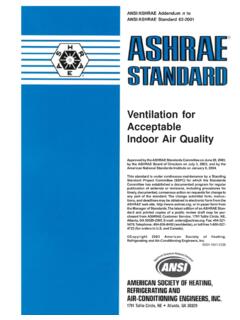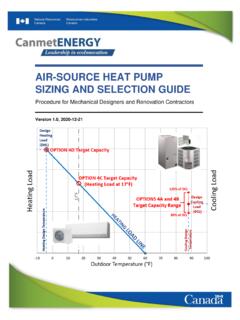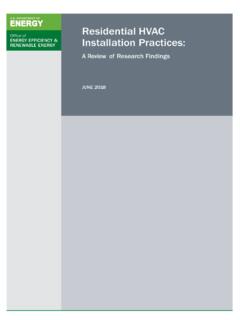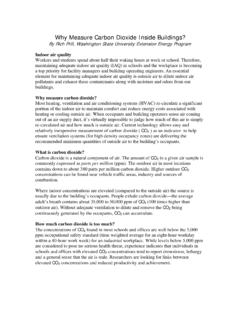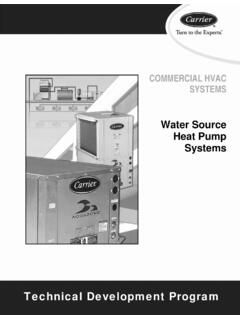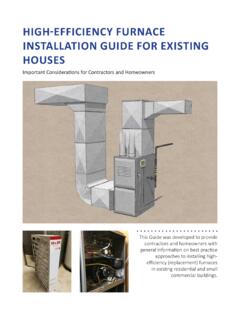Transcription of The Future of Air Conditioning for Buildings - Energy
1 The Future of Air Conditioning for Buildings July 2016. W. Goetzler, M. Guernsey, J. Young, J. Fuhrman Navigant Consulting, Inc. O. Abdelaziz, PhD. Oak Ridge National Laboratory (This page intentionally left blank). NOTICE. This report was prepared as an account of work sponsored by an agency of the United States Government. Neither the United States Government, nor any agency thereof, nor any of their employees, nor any of their contractors, subcontractors, or their employees, makes any warranty, express or implied, or assumes any legal liability or responsibility for the accuracy, completeness, or usefulness of any information, apparatus, product, or process disclosed, or represents that its use would not infringe privately owned rights. Reference herein to any specific commercial product, process, or service by trade name, trademark, manufacturer, or otherwise, does not necessarily constitute or imply its endorsement, recommendation, or favoring by the United States Government or any agency, contractor or subcontractor thereof.
2 The views and opinions of authors expressed herein do not necessarily state or reflect those of the United States Government or any agency thereof. Available electronically at Prepared for: Department of Energy Office of Energy Efficiency and Renewable Energy Building Technologies Office Prepared by: Navigant Consulting, Inc. 77 South Bedford Street, Suite 400. Burlington, MA 01803. William Goetzler Matt Guernsey Jim Young Jay Fuhrman Oak Ridge National Laboratory Oak Ridge, TN 37831. Omar Abdelaziz, PhD. THE Future OF AIR Conditioning FOR Buildings . List of Acronyms A/C Air Conditioning AHRI Air Conditioning , heating , and Refrigeration Institute AREP AHRI's Low-GWP Alternative Refrigerant Evaluation Program ASHRAE american society of heating , refrigerating , and Air- Conditioning Engineers BTO Building Technologies Office (Department of Energy , part of EERE). CAC Residential Central Air Conditioner CFC Chlorofluorocarbon CDD Cooling Degree Days CO2 Carbon Dioxide COP Coefficient of Performance CRAC Computer Room Air Conditioner DOE Department of Energy EER Energy Efficiency Ratio EERE DOE's Office of Energy Efficiency and Renewable Energy EEV Electronic Expansion Valve EIA Energy Information Administration EPA Environmental Protection Agency EU European Union GDP Gross Domestic Product GHG Greenhouse Gas GWP Global Warming Potential HAT High Ambient Temperature Test Conditions HC Hydrocarbon HCFC Hydrochlorofluorocarbon HFC Hydrofluorocarbon HFO Hydrofluoroolefin HVAC heating , Ventilation, and Air- Conditioning IEA International Energy Agency IECC International Energy Conservation Code IEER Integrated Energy Efficiency Ratio IPCC Intergovernmental Panel on Climate Change IT Information Technology LBNL Lawrence Berkeley National Laboratory ( ).
3 KWh Kilowatt-hour kWth Kilowatt (refrigeration capacity). MW Megawatt NIST National Institute for Standards and Technology ( ). NVC Non-Vapor Compression O&M Operations and Maintenance ODP Ozone Depletion Potential ODS Ozone Depleting Substance List of Acronyms i THE Future OF AIR Conditioning FOR Buildings . OECD Organization of Economic Coordination and Development OEM Original Equipment Manufacturer ORNL Oak Ridge National Laboratory ( ). PTAC Packaged Terminal Air Conditioner PTHP Packaged Terminal Heat Pump PV Solar Photovoltaics R&D Research and Development RT Refrigeration Ton RTU Rooftop Unit SEER Seasonal Energy Efficiency Ratio SNAP EPA's Significant New Alternatives Policy Program TXV Thermal Expansion Valve UN United Nations UNEP United Nations Environment Programme VRF Variable Refrigerant Flow ii List of Acronyms THE Future OF AIR Conditioning FOR Buildings . Executive Summary The Building Technologies Office (BTO), within the Department of Energy 's (DOE) Office of Energy Efficiency and Renewable Energy , works with researchers and industry to develop and deploy technologies that can substantially reduce Energy consumption and greenhouse gas (GHG) emissions in residential and commercial Buildings .
4 Air Conditioning (A/C) systems in Buildings contribute to GHG emissions both directly through refrigerant emissions, as well as indirectly through fossil fuel combustion for power generation. BTO promotes pre-competitive research and development (R&D) on next-generation HVAC technologies that support the phase down of hydrofluorocarbon (HFC) production and consumption, as well as cost-effective Energy efficiency improvements. Over the past several decades, product costs and lifecycle cooling costs have declined substantially in many global markets due to improved, higher-volume manufacturing and higher Energy efficiency driven by R&D investments and efficiency policies including minimum efficiency standards and labeling This report characterizes the current landscape and trends in the global A/C market, including discussion of both direct and indirect climate impacts, and potential global warming impacts from growing global A/C usage. The report also documents solutions that can help achieve international goals for Energy efficiency and GHG.
5 Emissions reductions. The solutions include pathways related to low-global warming potential2. (GWP) refrigerants, Energy efficiency innovations, long-term R&D initiatives, and regulatory actions. DOE provides, with this report, a fact-based vision for the Future of A/C use around the world. DOE intends for this vision to reflect a broad and balanced aggregation of perspectives. DOE. brings together this content in an effort to support dialogue within the international community and help keep key facts and objectives at the forefront among the many important discussions. Expected Growth in A/C Demand Today, A/C equipment represents close to a $100 billion, 100 million-unit per year global market, and accounts for exajoules ( Quadrillion Btus) of site Energy consumption per year3, comprising just over 4% of global building site- Energy While adoption of A/C in developed countries increased rapidly in the 20th century, the 21st century will see greater adoption in developing countries, especially those in hot and (possibly) humid climates with large and growing populations, such as India, China, Brazil, and Middle Eastern nations.
6 The International Energy Agency (IEA) projects that A/C Energy consumption by 2050 will increase times over 2010 levels for non-Organization of Economic Coordination and Development 1 R. D. Van Buskirk, et al. 2014. A Retrospective investigation of Energy efficiency standards: policies may have accelerated long term declines in appliance costs. Lawrence Berkeley National Laboratory. Available: retrospective-investigation-of-ener 2 Refers to the amount of heat a greenhouse gas traps in the atmosphere over a specified timeframe, relative to the same mass of CO2. This report uses 100-year GWP values from the IPCC Fifth Assessment Report. 3 Source or primary Energy consumption is approximately 3x site electricity consumption globally or EJ ( Quads. International Energy Agency. 2013. Transition to Sustainable Buildings : Strategies and Opportunities to 2050. Figure OECD/IEA. Available at: 4 International Energy Agency. 2013. Transition to Sustainable Buildings : Strategies and Opportunities to 2050.)
7 OECD/IEA. Available at: Executive Summary iii THE Future OF AIR Conditioning FOR Buildings . (OECD) countries versus times for OECD Rising income and greater access to A/C equipment in many of these nations opens the door to building cooling for billions of people, which will provide significant benefits in increased human health and comfort. Global Warming Contributions Globally, stationary A/C systems account for nearly 700 million metric tons of direct and indirect CO2-equivalent emissions (MMTCO2e) annually. Indirect emissions from electricity generation account for approximately 74% of this total, with direct emissions of HFC and hydrochlorofluorocarbon (HCFC) refrigerants accounting for 7% and 19%, ,6 While electricity consumption is the largest driver of GHG emissions from A/C ( , indirect impacts), emissions of HCFC and HFC refrigerants have a disproportionately large global warming impact relative to their mass. Addressing direct emissions therefore offers an important path to substantially reducing A/C GHG emissions.
8 Transitioning to low-GWP refrigerants could eliminate the vast majority of direct emissions from A/C systems. With many available low-GWP alternative refrigerants having GWPs of 100 or less, industry has the opportunity to implement high-impact solutions for all applications. A. theoretical 100% adoption of near-zero GWP refrigerants could reduce annual global A/C. emissions by up to 26%, assuming no changes in efficiency. With preliminary testing indicating the potential for efficiency improvements for equipment using low-GWP refrigerants, reductions to indirect emissions are possible as well, especially if high-efficiency equipment adoption is incentivized globally through efficiency standards and labeling programs. Given the refrigerant options available today, DOE sees opportunity to reduce global A/C GHG emissions by 20% or more (75% or more of all direct emissions). Such a transition could occur in as short as a single turnover cycle of installed equipment, and would limit direct emissions growth, especially in markets that lack effective refrigerant management programs.
9 In addition to a transition to low- GWP refrigerants, reducing emissions during initial charging, servicing, and end-of-life disposal could help further mitigate direct emissions. Deeper reductions in emissions are possible in the long-term from lower-GWP refrigerants and improved efficiency. Without action by the international community, the expected demand for A/C in developing countries in the coming decades will substantially increase global GHG emissions. Rising global temperatures resulting from climate change will only exacerbate the problem by increasing A/C. demand and contributing to further climate change. These impacts will go unchecked unless the international community takes steps to reduce direct and indirect emissions from A/C usage. The transition of Article 5 nations (as defined under the Montreal Protocol) from ozone-depleting, high-GWP HCFCs presents the opportunity to significantly reduce direct climate impacts by avoiding the uptake of high-GWP HFCs and transitioning directly to low-GWP alternatives.
10 Given the importance of both efficiency and refrigerant emissions, the total life cycle climate impacts of A/C systems, , both direct and indirect emissions, should be considered when evaluating approaches to transition from high-GWP refrigerants. 5 This analysis relies upon Energy consumption and emissions data from the 's Intergovernmental Panel on Climate Change, EPA, World Bank, and the Proceedings of the National Academy of Sciences. 6 Estimations of direct and indirect impacts are subject to significant uncertainty and depend heavily upon annual and end-of-life leakage rates, local climate, and electricity generation mix. iv Executive Summary THE Future OF AIR Conditioning FOR Buildings . Development of Low-GWP A/C Systems The A/C industry has a long history of proactively engaging and helping to meet environmental goals through international cooperation and technology innovation. Manufacturers successfully developed products to transition away from ozone-depleting refrigerants and continually innovate to deliver lower cost products with higher efficiency and performance.










